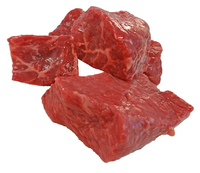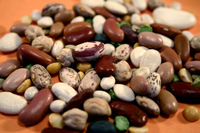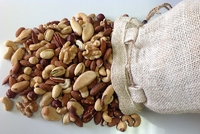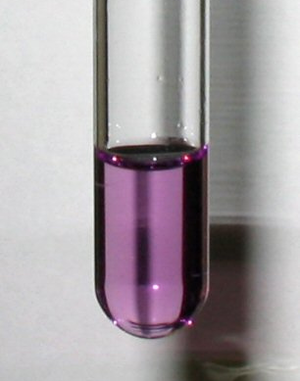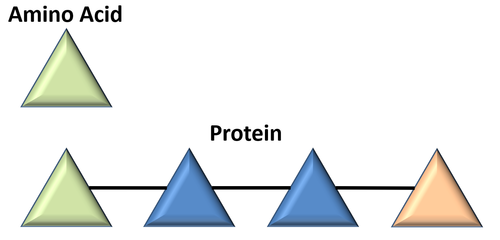Key Stage 3
Meaning
Proteins are molecules in our diet that are used by our bodies for growth and repair.
About Proteins
- There are many different proteins.
- Protein is used to build muscles and repair injuries.
- Not enough protein can cause a disease called Kwashiorkor.
Sources of Protein
Testing For Protein
- Adding protein to Biuret solution will cause the solution to turn purple.
Method
- 1. Take a small sample of food and dissolve it in water.
- 2. Add some Biuret to the solution.
- 3. If it turns from blue to purple then the food contained protein.
|
|
| This Biuret has turned purple, indicating protein is present.
|
Key Stage 4
Meaning
Proteins, also known as polypeptides, are large polymer molecules made from amino acids that are used by our bodies for growth and repair.
About Proteins
- Proteins (polypeptides) are formed in polymerisation reactions of Amino Acids (peptides).
- Proteins are broken down by our digestive systems into amino acids which are then transported around the body by our blood.
- Cells build new proteins from amino acids in a process called protein synthesis which takes place at the ribosomes in cells.
- Protein is essential to build enzymes which control the metabolic processes inside the cell.
- A single protein can be made of millions of amino acids bonded together.
Sources of Protein
Testing For Protein
- Adding protein to Biuret solution will cause the solution to turn purple.
Method
- 1. Take a small sample of food and dissolve it in water.
- 2. Add some Biuret to the solution.
- 3. If it turns from blue to purple then the food contained protein.
|
|
| This Biuret has turned purple, indicating protein is present.
|
References
AQA
- Polypeptide, page 251, GCSE Chemistry; Student Book, Collins, AQA
- Polypeptides, page 173, GCSE Chemistry; Third Edition, Oxford University Press, AQA
- Polypeptides, pages 192-3, GCSE Chemistry, Hodder, AQA
- Protein, pages 101, 104, 108, 192, 238, 241, 246-7, GCSE Biology; Student Book, Collins, AQA
- Protein, pages 226-7, 251, 253, 283, 322, GCSE Chemistry; Student Book, Collins, AQA
- Protein, test for, page 48, GCSE Combined Science Trilogy 1, Hodder, AQA
- Proteins (test for), page 28, GCSE Combined Science; The Revision Guide, CGP, AQA
- Proteins, page 173, GCSE Chemistry; Third Edition, Oxford University Press, AQA
- Proteins, page 193, GCSE Chemistry, Hodder, AQA
- Proteins, page 246, GCSE Chemistry, CGP, AQA
- Proteins, page 84, GCSE Chemistry; The Revision Guide, CGP, AQA
- Proteins, page 85, GCSE Biology; The Revision Guide, CGP, AQA
- Proteins, pages 34, GCSE Combined Science Trilogy 2, Hodder, AQA
- Proteins, pages 41, 46, 48, 129, 141, 204-205, 207, 309, GCSE Biology; Third Edition, Oxford University Press, AQA
- Proteins; function of, page 85, GCSE Biology; The Revision Guide, CGP, AQA
- Proteins; test for, page 32, GCSE Biology; The Revision Guide, CGP, AQA
Edexcel
- Polypeptides, page 59, GCSE Biology, Pearson, Edexcel
- Proteins, page 100, GCSE Chemistry; The Revision Guide, CGP, Edexcel
- Proteins, page 124, GCSE Biology, Pearson, Edexcel
- Proteins, page 17, GCSE Combined Science; The Revision Guide, CGP, Edexcel
- Proteins, page 185, GCSE Chemistry, Pearson, Edexcel
- Proteins, page 292, GCSE Chemistry, CGP, Edexcel
- Proteins, pages 18, 19, GCSE Biology; The Revision Guide, CGP, Edexcel
- Proteins, pages 41, 44, GCSE Biology, CGP, Edexcel
- Proteins; synthesis, pages 58-59, GCSE Biology, Pearson, Edexcel
OCR
- Proteins, page 20, Gateway GCSE Combined Science; The Revision Guide, CGP, OCR
- Proteins, page 91, Gateway GCSE Chemistry; The Revision Guide, CGP, OCR
- Proteins, pages 16, 23, Gateway GCSE Biology; The Revision Guide, CGP, OCR
- Proteins, pages 28, 30-31, 39, 62, 252, Gateway GCSE Biology, Oxford, OCR
- Proteins, pages 64, 245, 246, Gateway GCSE Chemistry, Oxford, OCR
- Proteins; synthesis, page 16, Gateway GCSE Biology; The Revision Guide, CGP, OCR
- Proteins; testing for, page 24, Gateway GCSE Biology; The Revision Guide, CGP, OCR
